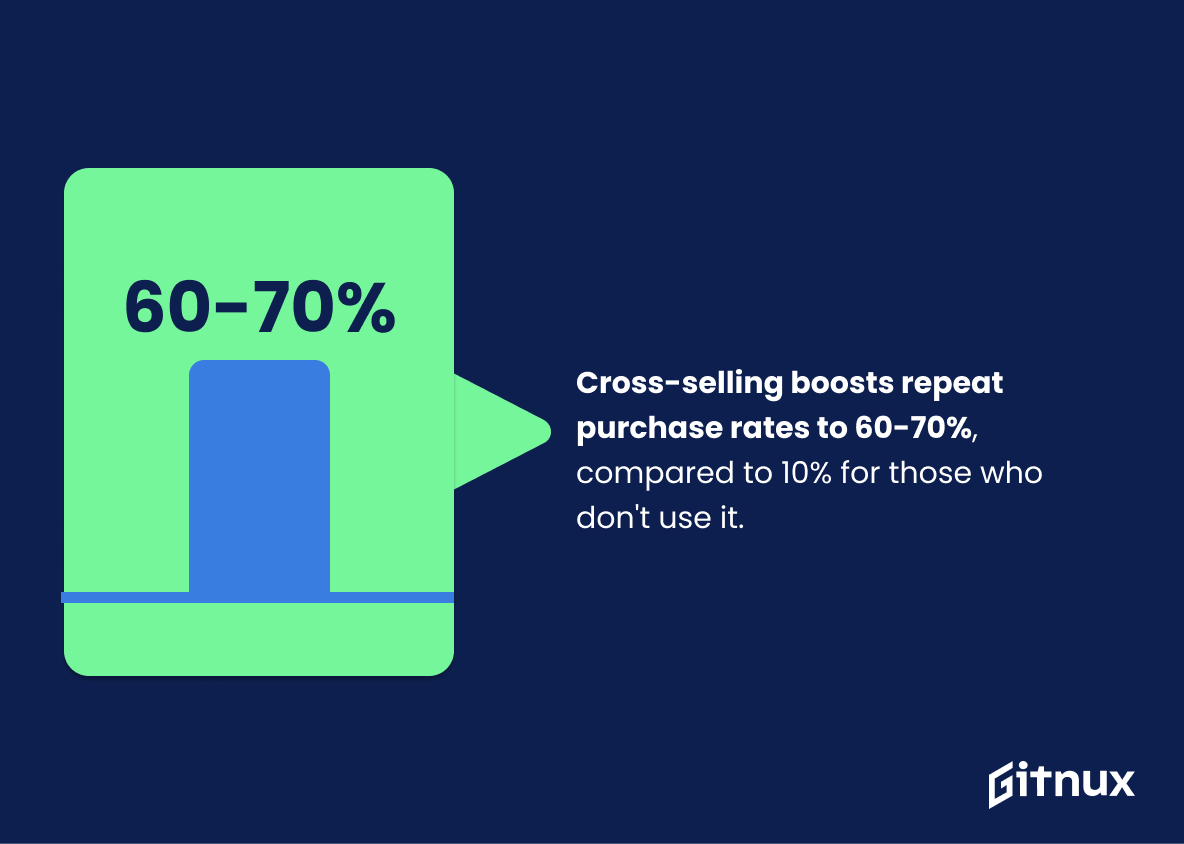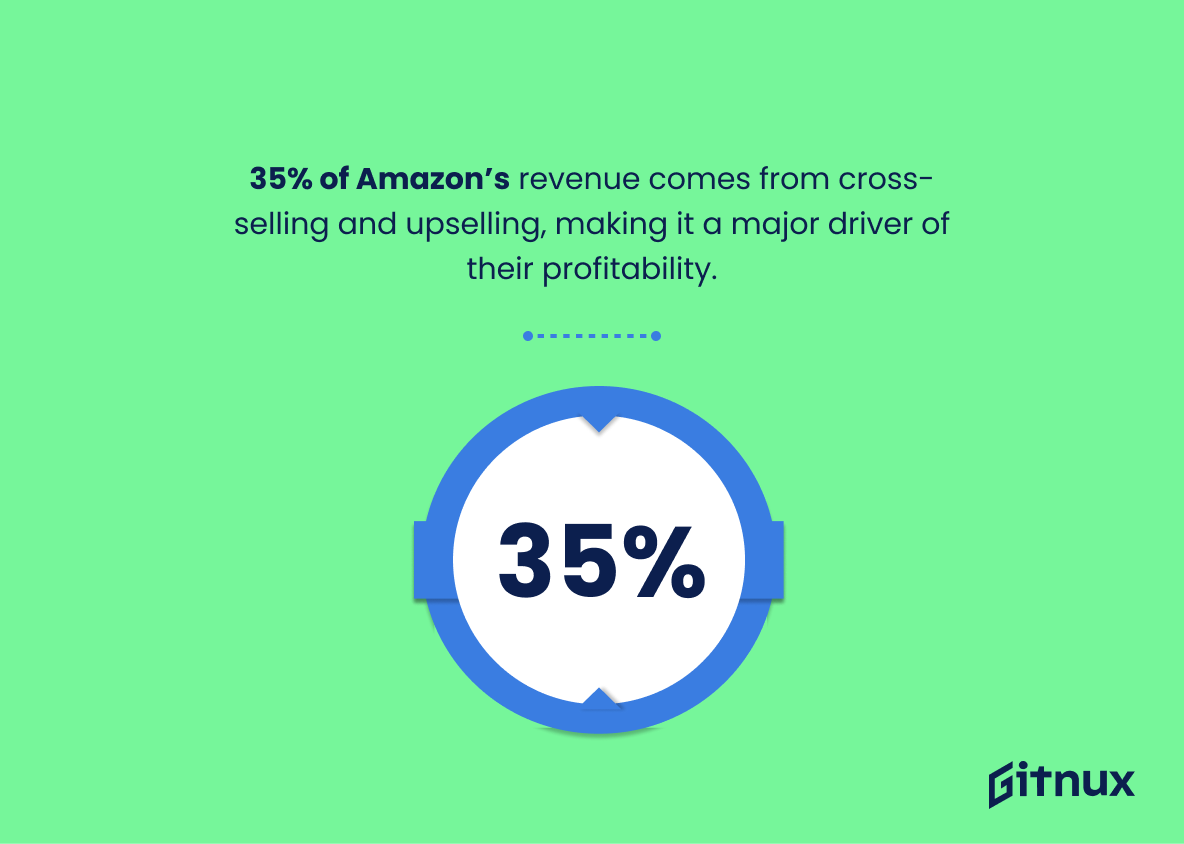In today’s competitive business landscape, companies are constantly seeking ways to increase their revenue and customer base. One effective way to achieve these goals is through cross-selling, a marketing strategy that involves offering complementary or related products or services to existing customers.
Cross-selling strategies have become increasingly popular in recent years, with more and more companies implementing the cross-selling strategy to drive growth and increase customer satisfaction. This article will explore the main cross-selling statistics trends, benefits, techniques, metrics, challenges and best practices.
Cross-Selling: The Most Important Statistics
Cross-selling can increase the lifetime value of a customer by up to 14%.
Businesses that use cross-selling techniques see a 20% increase in sales compared to businesses that don’t use these techniques.
What’s Driving Business Growth Today?
According to a report by Acceture, 91% of customers are more likely to shop with brands that provide personalized offers and recommendations. Therefore, businesses must invest in data collection and analysis to understand their customers’ needs and preferences, and then create customized offers and recommendations based on that data.
In 2020, 80% of e-commerce businesses in the United States reported using cross-selling and upselling tactics to increase sales.
The food and beverage industry has seen the most success with cross-selling, with an average of 25% of revenue coming from cross-selling efforts.
Consumer behavior increasingly impacts cross-selling efforts, with customers expecting a seamless and personalized experience across all touchpoints, including online and offline channels.
Mobile devices are becoming an increasingly important channel, with SMS messaging campaigns showing an open rate of 98% compared to just 20% for email campaigns.
What Are The Main Benefits Of Cross-Selling?
According to Hubspot, companies that implement cross-selling strategies can see an increase in revenue of up to 30%.
Cross-selling can help improve customer retention, as customers who purchase multiple products or services are more likely to be satisfied and continue doing business with a company.
Companies could achieve more efficient marketing efforts, as it is often less expensive and more effective to market to existing customers than to acquire new ones.
Companies can also better understand their customers’ needs and preferences, which can in turn help them develop new products and services that better meet those needs.
Cross-selling can help create a more complete and satisfying customer experience, as customers can easily find and purchase all the products or services they need in one place.
Maximizing Cross-Selling Opportunities With Effective Techniques
Personalized recommendations are one of the most effective cross-selling techniques, with a 35% increase in sales when recommendations are based on customer data.
Product bundling is another effective technique, with companies like McDonald’s reporting a 15-40% increase in revenue through bundled meal deals.
Loyalty programs are also thriving, with research showing that members of loyalty programs are 47% more likely to purchase non-members.
Dynamic cross-selling, which involves making real-time recommendations based on customers’ behavior and purchase history, can lead to a 20% increase in sales.
The Key Metrics to Track Cross-Selling
Conversion rate is an essential metric for measuring the success of cross-selling efforts, with companies reporting a 10-30% increase in conversion rates when cross-selling tactics are used.
Average order value (AOV) is another key metric, as cross-selling can increase the amount customers spend per order. Amazon, for example, saw a 35% increase in AOV through the use of cross-selling and upselling tactics.
Cross-selling can help increase the revenue a company generates from each customer over time. Research shows that companies that cross-sell effectively can see a 30-50% increase in Customer lifetime value (CLV).
Repeat purchase rate also represents a valuable metric to track, as cross-selling can help improve customer retention and encourage customers to make repeat purchases. Companies that use these tactics have been shown to have a 60-70% repeat purchase rate, compared to just 10% for companies that do not use cross-selling.
It is also relevant to consider customer satisfaction and loyalty as key metrics, as cross-selling can help create a more positive customer experience and build stronger relationships with customers. Research shows that companies implementing cross-selling strategies can see a 10% increase in customer loyalty.
It is crucial for companies to regularly track and analyze these metrics to evaluate the effectiveness of their strategies and make necessary adjustments.
What Are The Main Cross-Selling Challenges?
Cross-selling can be a powerful tool for increasing revenue and providing customer satisfaction, but it can also present several challenges for companies.
One of the main challenges of cross-selling is customer resistance. According to a study by McKinsey & Company, only 5-15% of customers are receptive to cross-selling efforts.
Customers are often skeptical about the value of cross-selling offers. A survey conducted by MarketingProfs found that only 20% of customers believed that its recommendations were relevant to their needs.
Targeting the right customers with the right offer is critical for cross-selling success. According to a survey by CEB, 85% of customers are unlikely to respond to cross-selling requests that are irrelevant to their needs.
Up-selling, which involves selling a more expensive version of the same product, is often confused with cross-selling. However, research by Accenture found that cross-selling is up to 20 times more effective than up-selling in terms of driving revenue growth.
Effective cross-selling requires staff to deeply understand the customer’s needs and the products or services offered. A study by Bain & Company found that only 10% of frontline employees were effective at cross-selling, indicating a need for more training and support.
Analyzing customer data is crucial for identifying cross-selling opportunities. However, only 15% of companies can use customer data effectively to drive cross-selling initiatives.
Building trust and credibility represent key points for success. Only 37% of customers believe that businesses are trustworthy, making it difficult to persuade them to purchase additional products or services.
Supplementary Statistics
35% of Amazon’s revenue comes from cross-selling and upselling, making it a major driver of their profitability.
Cross-selling contributes to 10-30% of e-commerce revenues.
This shows that by implementing cross-selling strategies, businesses can significantly increase their revenues. This statistic is a great starting point for any blog post about cross-selling statistics, as it provides a clear indication of the potential benefits of cross-selling.
75% of consumers said that they would be more likely to purchase from a retailer that leverages personalized offers based on past purchases or browsing habits.
The majority of consumers are open to the idea of personalized offers, and that they are likely to respond positively to them. This suggests that retailers should consider leveraging personalized offers in order to increase sales and customer loyalty.
65% of a company’s business comes from existing customers, highlighting the importance of cross-selling in retaining and growing business from current clients.
It demonstrates that a significant portion of a company’s business comes from existing customers, and that cross-selling is a key factor in ensuring that these customers remain loyal and continue to purchase from the company. This highlights the need for businesses to focus on cross-selling strategies in order to maximize their customer retention and growth.
Vodafone increased its cross-selling success rate by 275% when they employed personalization strategies.
By employing personalization strategies, Vodafone was able to significantly increase their success rate, making it clear that personalization is an invaluable tool for any business looking to maximize their cross-selling efforts.
B2B sellers who offer pricing transparency are 72% more likely to be cross-selling champions.
When B2B sellers make their pricing information available to customers, they are more likely to be successful in cross-selling. This is an important insight for any business looking to maximize their cross-selling efforts, as it highlights the importance of being open and transparent with customers about pricing.
Acquisition to conversion rates increased by 81% when companies used cross-selling as part of their e commerce process.
The remarkable 81% increase in acquisition to conversion rates when companies used cross-selling as part of their e commerce process is a testament to the power of this marketing strategy. This is a clear indication that cross-selling can be an effective tool for boosting sales and increasing customer loyalty. It is an invaluable piece of information for any business looking to maximize their online presence and maximize their profits.
89% of consumers prefer buying from a single centralized platform that offers a complete suite of services and products, highlighting the importance of cross-selling.
This indicates that cross-selling is an effective strategy for businesses to increase their sales and customer satisfaction.
Customers who cross-buy tend to find the relationship ten times as profitable as those who don’t.
It demonstrates that customers who take advantage of cross-selling opportunities can reap rewards that are far greater than those who don’t. This is an important point to consider when evaluating the potential of cross-selling, and it is a statistic that should not be overlooked.
Credit unions with effective cross-selling strategies have a 115% higher loan-to-share ratio.
Credit unions that have implemented successful cross-selling strategies have a significantly higher loan-to-share ratio than those that have not. This indicates that cross-selling can be a powerful tool for credit unions to increase their loan portfolio and generate more revenue.
Only 5-15% of existing B2B customers buy more than two products from a company, leaving significant opportunity for cross-selling strategies.
With only a small percentage of customers buying more than two products, there is a clear opportunity to increase revenue by targeting these customers and offering them additional products. By capitalizing on this opportunity, businesses can maximize their profits and gain a competitive edge.
Companies that use cross-selling tactics effectively achieve higher customer retention rates of up to 90%.
Companies that use cross-selling effectively can expect to see a dramatic increase in customer retention rates, up to a staggering 90%. This is an invaluable insight for any business looking to maximize customer loyalty and increase their bottom line.
When cross-selling, it’s 68% more expensive to acquire a new customer than retain an existing one.
It is far more cost-effective to focus on keeping existing customers happy than to try and acquire new ones. This is especially true in the current economic climate, where businesses need to be as efficient as possible with their resources.
Conclusion
Cross-selling is a powerful marketing strategy that can help businesses increase revenue, improve customer retention, and provide a more satisfying customer experience. Companies can drive growth and increase customer satisfaction by offering complementary or related products or services to existing customers.
Personalized recommendations, product bundling, loyalty programs, and dynamic cross-selling are some of the most effective cross-selling techniques. Although cross-selling can present challenges, such as customer resistance and targeting the right customers, companies can overcome them by investing in data collection and analysis. As well as providing a personalized and consistent experience across all touchpoints, and offering relevant and valuable cross-selling offers.
References
Perceptive Analytics: “Upselling and Cross-selling: Benefits, Strategies, Industrial Applications and Models” cited in February 2023 (Source)
HubSpot: “Cross-Selling and Upselling: The Ultimate Guide” cited in February 2023 (Source)
Seller App: “Amazon Average Order Value (AOV) & Its Significance In Ecommerce” cited in February 2023 (Source)
Shopney: “How McDonald’s Mastered Cross-Selling to Add 15-40% in Revenue (& How You Can Too)” cited in February 2023 (Source)
Verfacto: “Upselling and Cross-Selling: Everything You Need to Know” cited in February 2023 (Source)
2Checkout: “How to Choose Between Upselling and Cross-Selling” cited in February 2023 (Source)
McKinsey & Company: “The six c’s of cross-selling success” cited in February 2023 (Source)
Now Blitz: “5 Advantages of Cross Selling to Existing Customers” cited in February 2023 (Source)
Forbes: “Here’s What The Statistics Say About Cross-Selling And Upselling With SMS” cited in February 2023 (Source)
The Sales Funnel Strategist: “15 Upselling and Cross-Selling Statistics for 2023” cited in February 2023 (Source)
CXL: “7 Examples of Effective Cross-selling (and Why They Work)” cited in Februart 2023 (Source)
ZipDo, cited June 2023: Cross Selling Statistics















